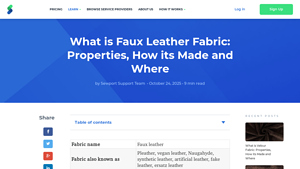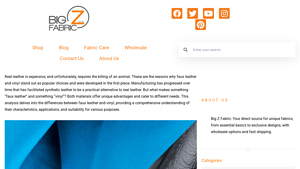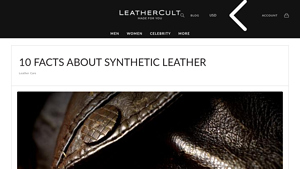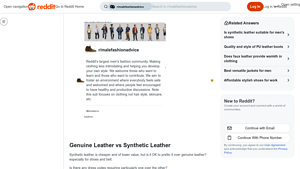Introduction: Navigating the Global Market for synthetic leather
As international B2B buyers seek to enhance their product offerings, sourcing high-quality synthetic leather presents both opportunities and challenges. The global market for synthetic leather, often referred to as faux leather or vegan leather, is rapidly evolving, driven by increasing demand for sustainable and cruelty-free alternatives to genuine leather. However, navigating this complex landscape requires a keen understanding of various types of synthetic leather, their applications, and the nuances of supplier vetting.
This comprehensive guide is designed to empower B2B buyers, particularly those from regions like Africa, South America, the Middle East, and Europe, including emerging markets such as Vietnam and Brazil. It covers essential topics such as the different types of synthetic leather, their respective applications across industries, and effective strategies for evaluating suppliers. Additionally, the guide delves into cost considerations, ensuring that buyers can make informed purchasing decisions that align with their business goals and budget constraints.
By equipping buyers with actionable insights and a thorough understanding of the synthetic leather market, this guide aims to facilitate successful sourcing decisions that cater to diverse consumer needs while addressing sustainability concerns. With the right knowledge, businesses can leverage the advantages of synthetic leather to enhance their product lines and meet the growing demand for ethical alternatives in the marketplace.
Table Of Contents
- Top 5 Synthetic Leather Manufacturers & Suppliers List
- Introduction: Navigating the Global Market for synthetic leather
- Understanding synthetic leather Types and Variations
- Key Industrial Applications of synthetic leather
- 3 Common User Pain Points for ‘synthetic leather’ & Their Solutions
- Strategic Material Selection Guide for synthetic leather
- In-depth Look: Manufacturing Processes and Quality Assurance for synthetic leather
- Practical Sourcing Guide: A Step-by-Step Checklist for ‘synthetic leather’
- Comprehensive Cost and Pricing Analysis for synthetic leather Sourcing
- Alternatives Analysis: Comparing synthetic leather With Other Solutions
- Essential Technical Properties and Trade Terminology for synthetic leather
- Navigating Market Dynamics and Sourcing Trends in the synthetic leather Sector
- Frequently Asked Questions (FAQs) for B2B Buyers of synthetic leather
- Strategic Sourcing Conclusion and Outlook for synthetic leather
- Important Disclaimer & Terms of Use
Understanding synthetic leather Types and Variations
| Type Name | Key Distinguishing Features | Primary B2B Applications | Brief Pros & Cons for Buyers |
|---|---|---|---|
| PVCレザー | Cost-effective, durable, low breathability | Upholstery, fashion accessories, automotive | Pros: Affordable, easy maintenance. Cons: Less breathable, environmental concerns. |
| PUレザー | Softer texture, better breathability than PVC | High-end fashion, furniture, automotive interiors | Pros: More premium feel, environmentally friendlier. Cons: Higher cost than PVC. |
| ヴィーガンレザー | Made from plant-based materials, eco-friendly | Eco-conscious brands, fashion, upholstery | Pros: Sustainable, cruelty-free. Cons: Can be less durable, higher production costs. |
| マイクロファイバー・レザー | Made from microfibers, high durability, soft feel | Upholstery, automotive, clothing | Pros: Highly durable, stain-resistant. Cons: Can be more expensive. |
| Recycled Leather | Made from recycled leather scraps, sustainable | Eco-friendly brands, furniture, accessories | Pros: Sustainable, unique textures. Cons: Limited availability, potential quality variability. |
What Are the Key Characteristics of PVC Leather for B2B Buyers?
PVC leather is a widely recognized synthetic leather option known for its cost-effectiveness and durability. It is produced using polyvinyl chloride, which provides a waterproof surface ideal for various applications such as upholstery and fashion accessories. However, its low breathability can be a drawback, particularly in applications where comfort is paramount. B2B buyers should consider the environmental implications of PVC production and the growing demand for more sustainable materials.
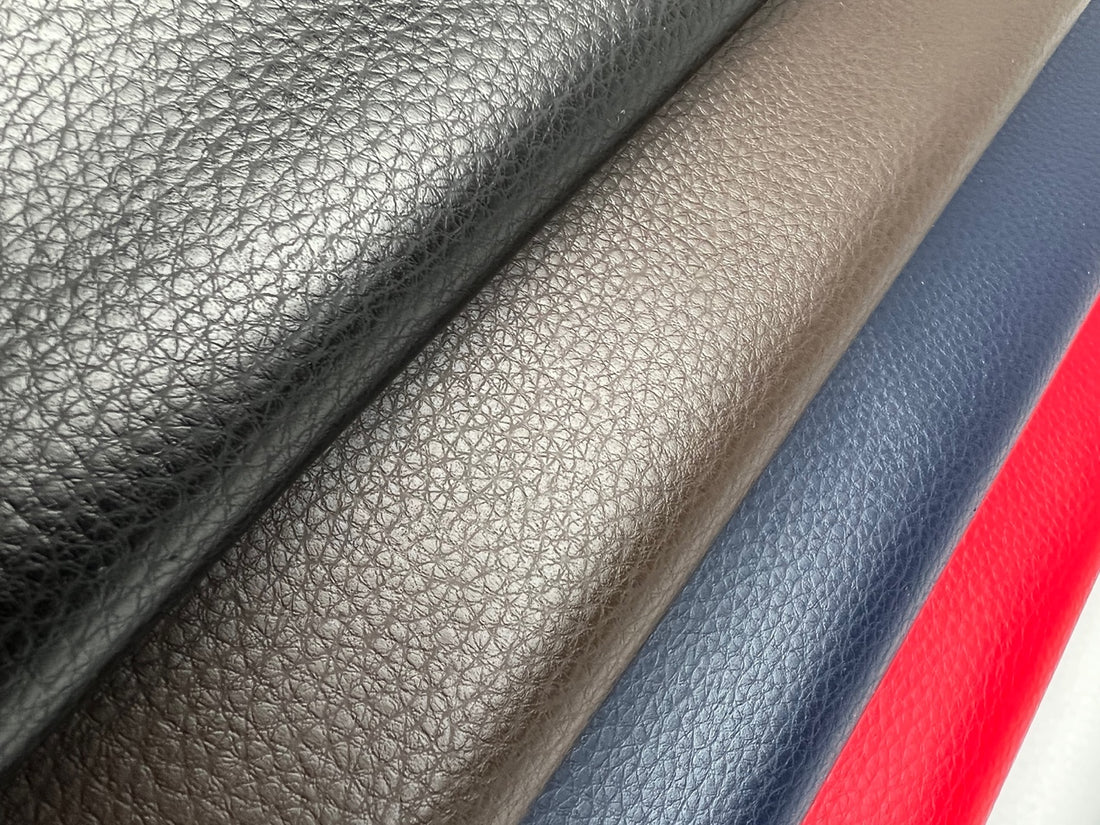
Illustrative image related to synthetic leather
How Does PU Leather Compare to Other Synthetic Leathers?
Polyurethane (PU) leather stands out for its softer texture and better breathability compared to PVC leather. It is often used in high-end fashion and automotive interiors, where a premium feel is desired. While PU leather generally comes at a higher price point, its environmental impact is less severe, making it an attractive option for brands focused on sustainability. Buyers should evaluate their target market’s preferences and budget when considering PU leather.
What Makes Vegan Leather a Sustainable Choice for B2B Applications?
Vegan leather, derived from plant-based materials, is gaining traction among eco-conscious brands. Its sustainable nature appeals to a growing demographic that prioritizes ethical consumption. While vegan leather can be less durable than traditional synthetic options, its unique selling proposition lies in its cruelty-free production methods. B2B buyers should assess their brand’s commitment to sustainability and whether vegan leather aligns with their product offerings.
Why Is Microfiber Leather Becoming Popular in Various Industries?
Microfiber leather is recognized for its high durability and soft feel, making it a preferred choice for upholstery, automotive, and clothing applications. Its resistance to stains and ease of cleaning enhance its appeal in environments with high wear and tear. However, buyers should be aware that microfiber leather often comes at a premium price. Evaluating the balance between durability and cost is crucial for B2B buyers when selecting this material.
What Are the Benefits of Using Recycled Leather in Products?
Recycled leather offers a sustainable alternative by utilizing scraps from traditional leather production. This material not only reduces waste but also provides unique textures that can appeal to consumers seeking individuality in their products. While the availability of recycled leather can be limited and quality may vary, its eco-friendly benefits make it a compelling choice for brands aiming to enhance their sustainability profile. B2B buyers should consider the sourcing and production processes of recycled leather to ensure consistent quality.
Key Industrial Applications of synthetic leather
| Industry/Sector | Specific Application of synthetic leather | Value/Benefit for the Business | Key Sourcing Considerations for this Application |
|---|---|---|---|
| Automotive | Upholstery for car interiors | Cost-effective, lightweight, and easy to clean options for vehicle interiors. | Ensure compliance with automotive standards and safety regulations. |
| Fashion & Apparel | Clothing and accessories | Versatile designs that appeal to eco-conscious consumers while being budget-friendly. | Look for suppliers offering a variety of colors and textures. |
| Furniture | Sofas and seating solutions | Durable, stain-resistant upholstery that enhances aesthetics without high costs. | Consider durability ratings and maintenance requirements. |
| Sports Equipment | Protective gear and apparel | Provides comfort and flexibility while ensuring durability in high-performance scenarios. | Verify material specifications for breathability and stretchability. |
| Home Décor | Wall coverings and decorative items | Offers a modern aesthetic with low maintenance, suitable for diverse applications. | Assess environmental impact and sourcing practices of suppliers. |
How is Synthetic Leather Used in the Automotive Industry?
In the automotive sector, synthetic leather is primarily utilized for upholstery in vehicle interiors, including seats, dashboards, and door panels. This material presents a cost-effective alternative to genuine leather, providing durability and ease of maintenance, which is crucial in regions like Africa and South America where vehicle upkeep can be challenging. Buyers should prioritize suppliers that adhere to automotive safety standards and offer products with low VOC emissions to ensure a healthier interior environment.
What are the Applications of Synthetic Leather in Fashion and Apparel?
In the fashion and apparel industry, synthetic leather is used for a variety of products, including jackets, handbags, and footwear. Its versatility allows designers to create trendy items at a lower price point, appealing to both budget-conscious consumers and those seeking cruelty-free options. International buyers, particularly in Europe and the Middle East, should consider sourcing from manufacturers that provide a wide range of colors and finishes, as well as those who follow sustainable production practices.
How is Synthetic Leather Beneficial in Furniture?
Synthetic leather is commonly employed in the furniture sector for upholstery on sofas, chairs, and other seating solutions. It offers durability and stain resistance, making it an ideal choice for homes with children or pets. Additionally, its aesthetic appeal can enhance the overall design of a space without the high costs associated with genuine leather. Buyers should focus on the durability ratings and maintenance requirements of the products to ensure long-lasting use.
What Role Does Synthetic Leather Play in Sports Equipment?
In the sports equipment industry, synthetic leather is used in protective gear, apparel, and various sports accessories. This material provides the necessary comfort and flexibility required for high-performance activities, while also being resistant to wear and tear. Buyers in regions like Brazil and Vietnam should verify the specifications related to breathability and stretchability to ensure the equipment meets performance standards and enhances user experience.
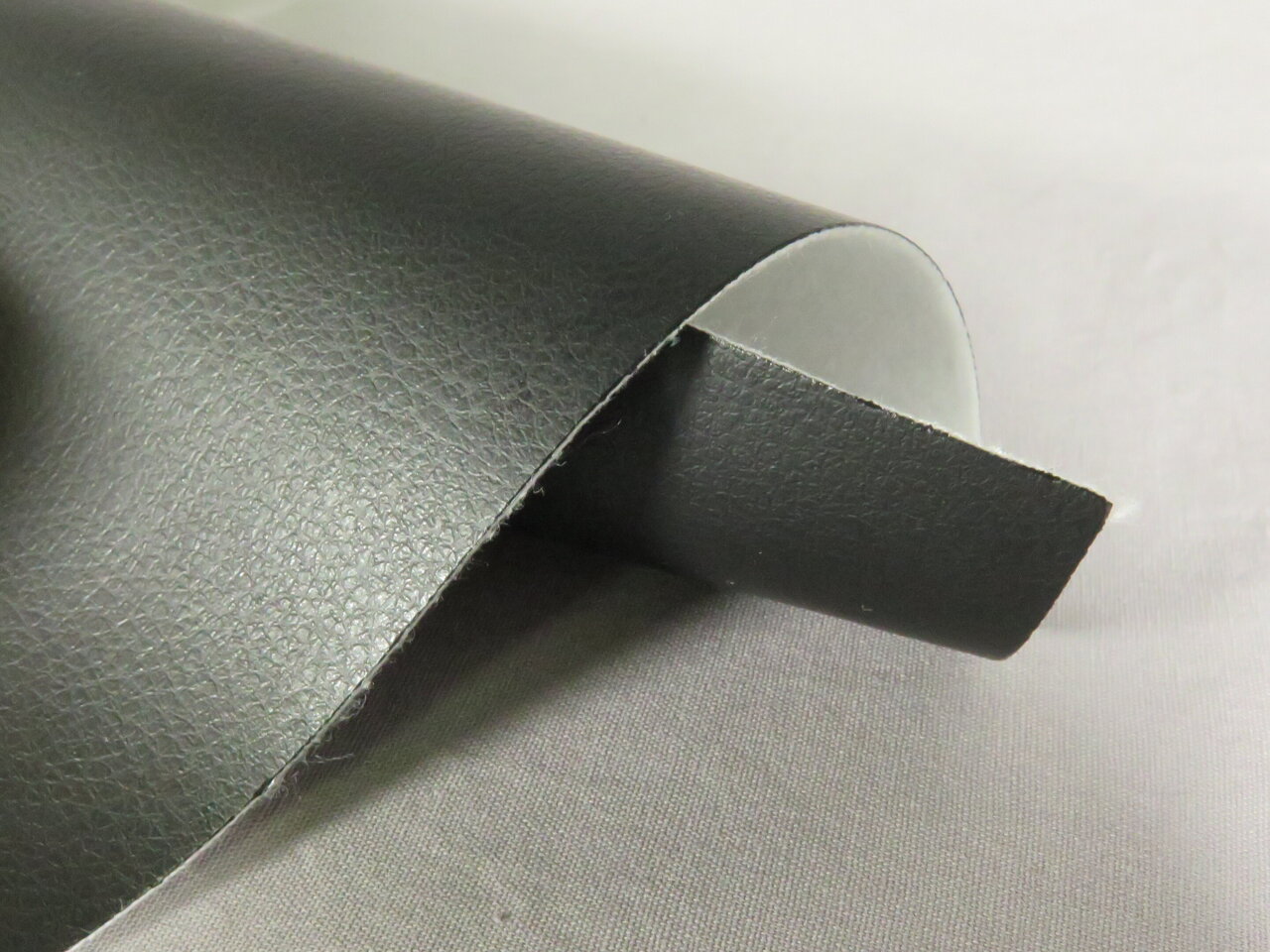
Illustrative image related to synthetic leather
How is Synthetic Leather Applied in Home Décor?
In home décor, synthetic leather is increasingly used for wall coverings, decorative items, and even rugs. Its modern aesthetic and low maintenance requirements make it an attractive option for interior design. Buyers should assess the environmental impact of the products they source and consider suppliers that prioritize sustainable manufacturing processes, especially in markets where eco-friendliness is becoming a key purchasing criterion.
3 Common User Pain Points for ‘synthetic leather’ & Their Solutions
Scenario 1: Sourcing High-Quality Synthetic Leather
The Problem: One of the most significant challenges B2B buyers face when sourcing synthetic leather is ensuring the quality and durability of the material. With a saturated market, especially from countries like China, distinguishing between high-grade and low-quality synthetic leather can be daunting. Buyers may encounter products that look appealing but fail to perform under stress, leading to customer dissatisfaction and potential returns. This is particularly crucial for businesses in the fashion and upholstery sectors, where the durability and aesthetic appeal of synthetic leather directly impact their brand reputation.
The Solution: To overcome this challenge, B2B buyers should implement a thorough vetting process when selecting suppliers. Start by requesting samples from multiple manufacturers to compare textures, flexibility, and overall finish. It’s also advisable to inquire about the manufacturing processes and materials used, specifically whether they use PVC or PU, as PU is generally more durable and environmentally friendly. Establishing relationships with suppliers who provide transparency about their sourcing and production methods can lead to more reliable partnerships. Additionally, consider conducting background checks on suppliers and looking for certifications or compliance with international standards, which can serve as a quality assurance measure.
Scenario 2: Environmental Concerns and Compliance
The Problem: With increasing scrutiny on environmental practices, B2B buyers are often confronted with the challenge of sourcing synthetic leather that aligns with sustainability goals. Traditional synthetic leathers made from PVC can release harmful chemicals during production and are not biodegradable, raising concerns among eco-conscious consumers. This situation places buyers in a difficult position, as they must balance product performance and compliance with environmental standards while meeting customer expectations for sustainability.

Illustrative image related to synthetic leather
The Solution: To address this issue, B2B buyers should actively seek out suppliers who produce eco-friendly synthetic leather alternatives. Look for products made from vegetable-based materials or those that utilize recycled plastics, which can significantly reduce the environmental footprint. Furthermore, engage in dialogues with suppliers about their sustainability practices, including waste management and chemical usage. By prioritizing partnerships with manufacturers committed to sustainable practices, buyers can not only improve their product offerings but also enhance their brand image in a market increasingly driven by environmental concerns.
Scenario 3: Performance Limitations in Extreme Conditions
The Problem: Buyers in regions with extreme climates often find that synthetic leather products do not perform as well as expected. For instance, in humid environments, conventional synthetic leathers may lack breathability, leading to discomfort and reduced product lifespan. Similarly, in colder climates, the heat retention properties of synthetic leather can be a double-edged sword, as excessive heat can cause warping or degradation over time. This discrepancy can lead to product failures and customer complaints, ultimately affecting business profitability.
The Solution: To mitigate these performance limitations, B2B buyers should focus on sourcing synthetic leather specifically designed for their target environment. For humid regions, look for breathable synthetic leathers that incorporate moisture-wicking properties. In colder climates, consider materials that maintain thermal regulation without compromising durability. Additionally, conducting field tests before bulk purchasing can provide invaluable insights into how the synthetic leather performs under local conditions. Collaborating with suppliers who specialize in climate-adapted materials can also yield better results, ensuring that the products meet the specific demands of the market while enhancing customer satisfaction.
Strategic Material Selection Guide for synthetic leather
What Are the Key Materials Used in Synthetic Leather Production?
Synthetic leather, also known as faux leather, is primarily made from various plastic materials, each with unique properties that influence their suitability for different applications. Understanding these materials is crucial for international B2B buyers, especially those operating in diverse markets like Africa, South America, the Middle East, and Europe.
What Are the Key Properties of Polyvinyl Chloride (PVC)?
PVC is one of the most widely used materials in the production of synthetic leather. It is known for its durability and resistance to moisture, making it a popular choice for upholstery and fashion accessories. PVC synthetic leather can withstand moderate temperatures and is relatively resistant to abrasion, which is essential for products like bags and shoes.

Illustrative image related to synthetic leather
Pros: PVC is cost-effective and easy to manufacture, allowing for mass production. Its water-resistant properties make it suitable for various applications, including outdoor furniture and automotive interiors.
Cons: However, PVC is less breathable than other materials, which can lead to discomfort in clothing applications. Additionally, the environmental impact of PVC production is a concern, as it involves harmful chemicals and is not biodegradable.
Impact on Application: PVC synthetic leather is compatible with various media, including inks and adhesives, making it versatile for different manufacturing processes.
Considerations for International Buyers: Buyers should ensure compliance with local environmental regulations, especially in regions like Europe where stringent standards exist. Familiarity with ASTM and DIN standards will aid in quality assurance.
How Does Polyurethane (PU) Compare as a Synthetic Leather Material?
Polyurethane (PU) is another popular choice for synthetic leather, known for its softness and flexibility. It mimics the feel of genuine leather more closely than PVC, making it ideal for high-end fashion items and upholstery.
Pros: PU offers superior breathability and is more environmentally friendly than PVC, as it can be produced using less harmful chemicals. Its aesthetic appeal and comfort make it suitable for premium products.
Cons: While PU is durable, it may not withstand the same level of abrasion as PVC, making it less suitable for high-wear applications. Additionally, PU can be more expensive to produce, impacting the final product’s cost.
Impact on Application: PU is compatible with a range of dyes and finishes, allowing for a variety of aesthetic options in fashion and upholstery.
Considerations for International Buyers: Buyers should be aware of the differences in manufacturing standards across countries. For instance, while PU may meet European standards for safety and environmental impact, it might not be as rigorously tested in other regions.
What Role Does Recycled Materials Play in Synthetic Leather Production?
Recycled materials, such as recycled plastics and textiles, are increasingly being used to produce synthetic leather. This approach addresses environmental concerns associated with traditional synthetic leather production.
Pros: Utilizing recycled materials reduces waste and the environmental footprint of synthetic leather. It can also appeal to eco-conscious consumers, providing a market advantage.
Cons: The quality and durability of recycled synthetic leather can vary significantly based on the source materials and manufacturing processes. This variability can affect product consistency.
Impact on Application: Recycled synthetic leather can be used in a wide range of applications, from fashion to automotive interiors, but may require specific compatibility testing based on the recycled content.
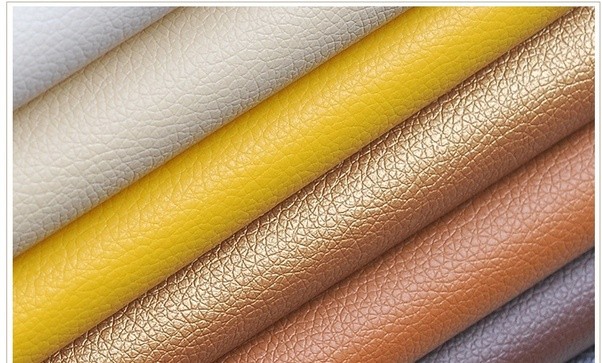
Illustrative image related to synthetic leather
Considerations for International Buyers: Buyers should verify the sustainability claims of suppliers and ensure compliance with local regulations regarding recycled materials. Understanding certifications like Global Recycle Standard (GRS) can aid in sourcing decisions.
Summary Table of Synthetic Leather Materials
| 素材 | Typical Use Case for synthetic leather | Key Advantage | Key Disadvantage/Limitation | Relative Cost (Low/Med/High) |
|---|---|---|---|---|
| PVC | Upholstery, bags, automotive interiors | Cost-effective, water-resistant | Less breathable, environmental concerns | 低い |
| PU | Fashion items, high-end upholstery | Soft, flexible, eco-friendlier | Higher cost, lower abrasion resistance | Med |
| Recycled Materials | Fashion, automotive, upholstery | Reduces waste, appeals to eco-conscious | Variable quality, inconsistent durability | Med |
This strategic material selection guide provides B2B buyers with essential insights into the properties, advantages, and limitations of different synthetic leather materials, enabling informed decision-making for their specific applications.
In-depth Look: Manufacturing Processes and Quality Assurance for synthetic leather
What Are the Main Stages of Synthetic Leather Manufacturing?
The production of synthetic leather involves several key stages, each critical for ensuring the quality and performance of the final product. Understanding these stages will help B2B buyers make informed decisions when sourcing synthetic leather.
How Is Material Prepared for Synthetic Leather Production?
The initial stage of synthetic leather manufacturing begins with material preparation. Manufacturers typically use either cotton or polyester as the base fabric due to their durability and ability to bond well with plastic layers. The base materials are treated to enhance their properties, ensuring they can withstand the subsequent processes.
In addition to traditional materials, some manufacturers are exploring vegetable-based alternatives, which present an eco-friendlier option. These innovative materials require specific handling and processing techniques to maintain their integrity throughout production.
What Techniques Are Used in Forming Synthetic Leather?
The forming stage is where the transformation into synthetic leather occurs. The two primary plastics used in this process are polyurethane (PU) and polyvinyl chloride (PVC).
-
PU Production: This involves a complex chemical reaction between isocyanates and polyols, along with various additives to achieve flexibility. Once formulated, the PU is applied to the base fabric using techniques such as coating or lamination.
-
PVC Production: This process begins with combining salt and petroleum to create ethylene dichloride, which is then polymerized into PVC. Similar to PU, the PVC is bonded to the base material through melting and overlaying techniques.
The choice between PU and PVC often depends on the desired characteristics of the synthetic leather, such as breathability, durability, and cost.
How Is the Assembly of Synthetic Leather Completed?
After the forming process, the synthetic leather is assembled. This involves cutting the material into specific shapes and sizes based on the intended applications, whether for upholstery, clothing, or accessories. Precision in cutting is essential to minimize waste and ensure uniformity in the final products.
During assembly, additional layers or features may be added, such as backing materials for enhanced strength or aesthetic finishes. This stage also involves quality checks to identify any defects before moving forward.
What Finishing Processes Enhance Synthetic Leather Quality?
The finishing stage is crucial for enhancing the visual appeal and functionality of synthetic leather. This may include processes such as embossing, dyeing, or applying protective coatings. Finishing not only contributes to the aesthetic qualities but also influences durability and resistance to stains or abrasions.
Some manufacturers are now focusing on eco-friendly finishes to appeal to environmentally conscious markets, particularly in regions where sustainability is increasingly valued.
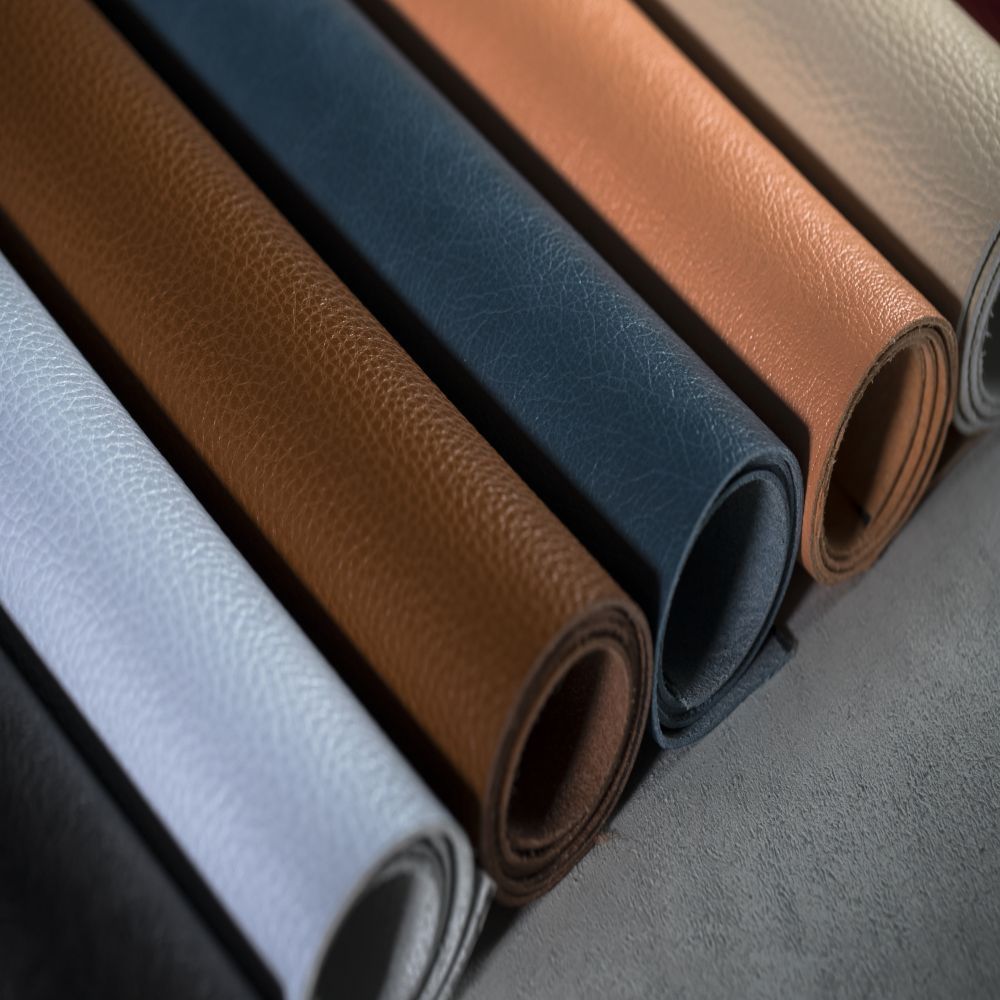
Illustrative image related to synthetic leather
What Quality Assurance Standards Are Relevant for Synthetic Leather?
Quality assurance (QA) in synthetic leather production is vital for maintaining product consistency and compliance with international standards. B2B buyers should be aware of the following standards:
-
ISO 9001: This global standard specifies requirements for a quality management system (QMS). Adhering to ISO 9001 ensures that manufacturers consistently provide products that meet customer and regulatory requirements.
-
CE Marking: For synthetic leather products sold in the European Economic Area, CE marking indicates conformity with health, safety, and environmental protection standards.
-
API Standards: In specific applications, such as automotive or medical, adherence to industry-specific standards like those from the American Petroleum Institute (API) may be necessary.
What Are the Key QC Checkpoints in Synthetic Leather Production?
Quality control is an ongoing process throughout the synthetic leather manufacturing stages. Key checkpoints include:
-
Incoming Quality Control (IQC): This initial inspection assesses raw materials for compliance with specifications. It’s crucial for ensuring that only high-quality base fabrics and chemicals are used.
-
In-Process Quality Control (IPQC): Continuous monitoring during the production process helps identify defects early. This includes checking for consistency in material thickness, bonding quality, and surface finish.
-
Final Quality Control (FQC): Before products are shipped, final inspections are conducted to ensure they meet all specifications and standards. This may involve physical testing, such as tensile strength or abrasion resistance.
What Common Testing Methods Are Used for Synthetic Leather?
Several testing methods are standard in the synthetic leather industry to verify product performance and compliance:
-
Tensile Testing: Measures the strength and elasticity of the material, ensuring it can withstand stress without tearing.
-
Abrasion Resistance Testing: Evaluates how well the synthetic leather can resist wear and tear, which is critical for upholstery and apparel applications.
-
Color Fastness Testing: Assesses the stability of colors under various conditions, including exposure to light and washing.
-
Chemical Resistance Testing: Determines the material’s ability to withstand exposure to various chemicals, essential for applications in automotive or industrial settings.
How Can B2B Buyers Verify Supplier Quality Control?
To ensure that suppliers maintain rigorous quality control practices, B2B buyers should consider the following approaches:
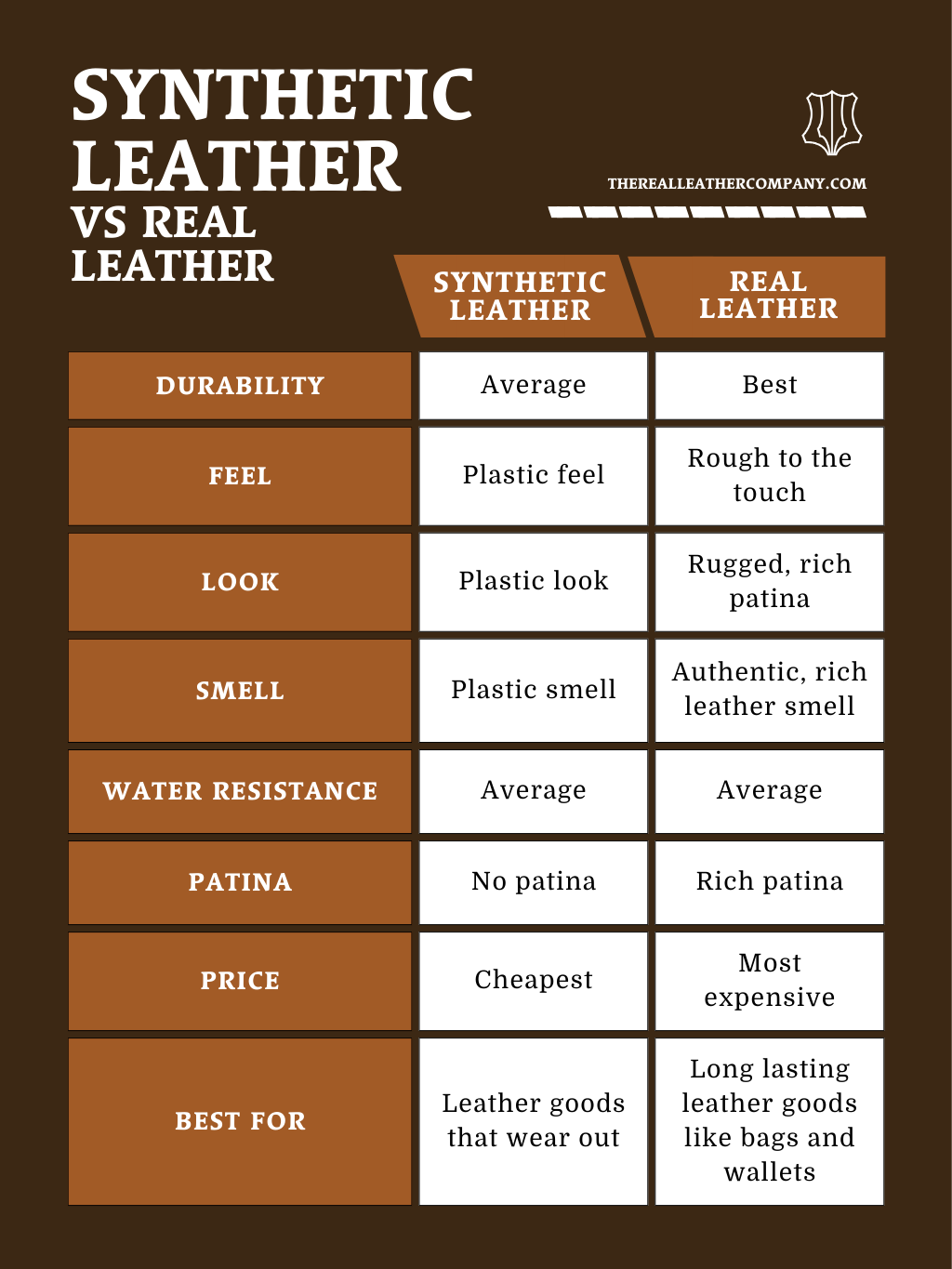
Illustrative image related to synthetic leather
-
Conduct Audits: Regular audits of suppliers can provide insights into their production processes and adherence to quality standards. Buyers should assess the supplier’s QMS and any certifications they hold.
-
Request Quality Reports: Suppliers should be able to provide documentation of their quality control processes, including testing results and compliance with international standards.
-
Utilize Third-Party Inspections: Engaging third-party inspection services can offer an unbiased evaluation of the supplier’s quality control practices and product quality before shipment.
What QC and Certification Nuances Should International Buyers Be Aware Of?
International B2B buyers, particularly from Africa, South America, the Middle East, and Europe, should be aware of regional variations in quality standards and certifications.
-
Local Regulations: Different countries may have specific regulations concerning synthetic materials, requiring compliance beyond international standards. Understanding these local requirements is essential for smooth market entry.
-
Cultural Expectations: In certain markets, there may be heightened expectations regarding sustainability and ethical sourcing. Buyers should ensure that their suppliers align with these values to avoid reputational risks.
-
Logistical Considerations: Shipping synthetic leather products internationally may involve additional quality checks to meet destination country standards, which can impact lead times and costs.
By understanding the manufacturing processes and quality assurance standards for synthetic leather, B2B buyers can make informed decisions, ensuring that they source high-quality products that meet their specific needs.
Practical Sourcing Guide: A Step-by-Step Checklist for ‘synthetic leather’
In today’s competitive marketplace, sourcing synthetic leather requires a structured approach to ensure quality, compliance, and cost-effectiveness. This guide provides a practical checklist for B2B buyers to navigate the sourcing process efficiently.
Step 1: Define Your Technical Specifications
Establishing clear technical specifications is crucial to ensure that the synthetic leather meets your product requirements. Consider factors such as thickness, finish, color, and intended applications. Documenting these specifications helps communicate your needs to potential suppliers and facilitates more accurate quotes.
Step 2: Research Market Trends and Innovations
Understanding the latest trends in synthetic leather is essential for making informed decisions. Explore innovations such as eco-friendly options or advancements in durability and aesthetics. This knowledge not only positions you competitively but also aligns your sourcing strategy with consumer preferences, particularly in regions increasingly valuing sustainability.
Step 3: Evaluate Potential Suppliers
Before committing to a supplier, it’s vital to conduct thorough evaluations. Request detailed company profiles, product samples, and references from other businesses in your industry. Look for suppliers with a proven track record in your target markets—this can provide insights into their reliability and quality standards.
- Supplier Certifications: Ensure the supplier holds relevant certifications that demonstrate compliance with industry standards and environmental regulations. This is especially important if you are sourcing from regions with stringent guidelines.
Step 4: Request Samples for Quality Assessment
Obtaining samples is a critical step in evaluating the quality of synthetic leather. Assess the samples for texture, durability, and color fidelity against your specifications. This hands-on assessment can reveal potential issues that may not be apparent through digital representations.
Step 5: Negotiate Terms and Conditions
Once you have identified a suitable supplier, enter into negotiations focusing on terms that protect your interests. Discuss pricing, payment terms, delivery schedules, and return policies. Clear agreements help mitigate risks and set expectations for both parties.
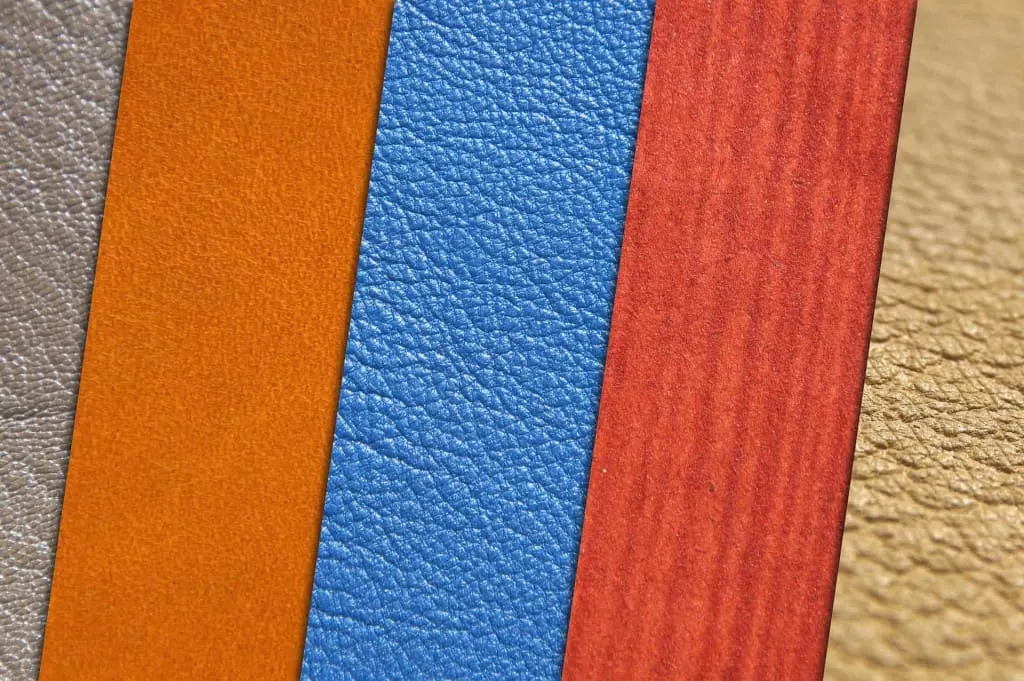
Illustrative image related to synthetic leather
Step 6: Confirm Logistics and Supply Chain Reliability
Understanding the logistics involved in sourcing synthetic leather is key to maintaining a smooth supply chain. Discuss shipping options, lead times, and potential customs implications, especially if importing from overseas. Reliable logistics ensure timely delivery and can prevent costly production delays.
Step 7: Establish a Communication Protocol
Effective communication with your supplier can significantly impact the success of your sourcing strategy. Set up regular check-ins and establish points of contact for resolving issues quickly. This ongoing dialogue fosters a stronger partnership and enhances responsiveness to any challenges that may arise.
By following these steps, B2B buyers can navigate the complexities of sourcing synthetic leather with confidence, ensuring that they select the right materials for their products while building strong supplier relationships.
Comprehensive Cost and Pricing Analysis for synthetic leather Sourcing
What Are the Key Cost Components in Synthetic Leather Sourcing?
When sourcing synthetic leather, understanding the cost structure is crucial for B2B buyers. The primary cost components include materials, labor, manufacturing overhead, tooling, quality control (QC), logistics, and supplier margins.
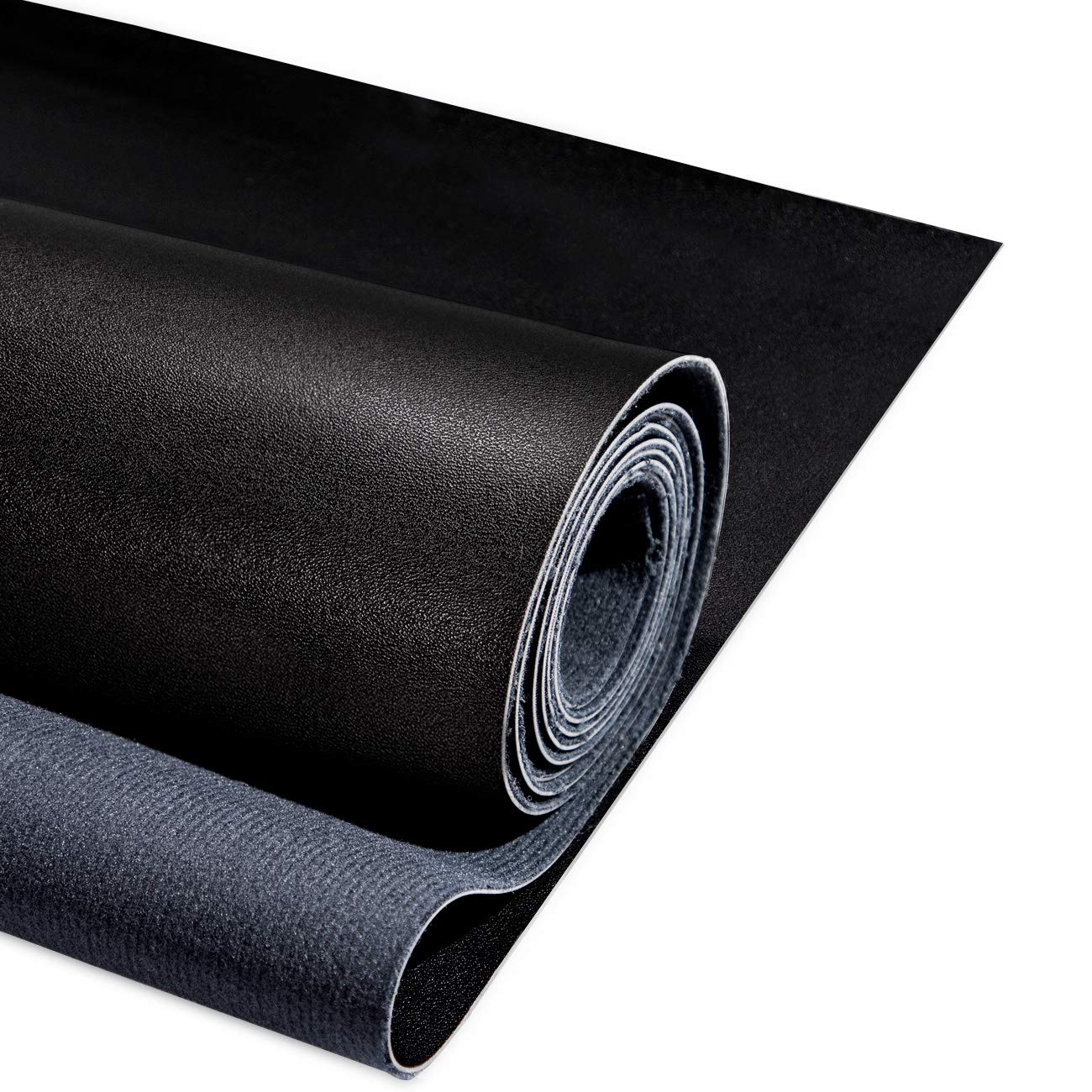
Illustrative image related to synthetic leather
-
Materials: The two main materials used in synthetic leather production are polyurethane (PU) and polyvinyl chloride (PVC). The choice between these materials significantly affects the cost, as PU is generally more expensive due to its superior quality and environmental benefits.
-
Labor: Labor costs can vary depending on the manufacturing location. Regions with lower labor costs may provide more competitive pricing, but this can sometimes come at the expense of quality.
-
Manufacturing Overhead: This includes utilities, rent, and equipment depreciation. Facilities that are more automated may have lower overhead costs, which can translate into lower prices for buyers.
-
Tooling: This refers to the costs associated with creating molds and dies for production. Custom tooling can significantly increase initial costs, especially for specialized designs or patterns.
-
Quality Control (QC): Ensuring that the synthetic leather meets specific standards is essential, particularly for international buyers who may require certifications. QC processes can add to the overall cost but are vital for maintaining product integrity.
-
Logistics: Transportation costs can vary widely based on the origin of the materials, the destination market, and the chosen shipping method. International buyers should consider these costs as part of their total expenditure.
-
Margin: Suppliers will include a profit margin in their pricing. Understanding the typical margins in the industry can help buyers negotiate better deals.
How Do Pricing Influencers Affect Synthetic Leather Costs?
Several factors influence the pricing of synthetic leather, which can vary significantly across different markets.
-
Volume/MOQ: Buyers often benefit from lower prices per unit when purchasing in larger quantities. Understanding the minimum order quantities (MOQs) required by suppliers can help buyers plan their purchases effectively.
-
Specifications and Customization: Custom designs or specialized specifications typically incur additional costs. Buyers should clearly outline their needs to avoid unexpected expenses.
-
Materials and Quality: The choice of materials and the required quality certifications can significantly impact pricing. Higher-quality synthetic leather, such as vegetable-based alternatives, may come at a premium.
-
Supplier Factors: The reputation and reliability of the supplier can affect pricing. Established suppliers with a track record of quality may charge more, but they often provide better assurance of consistent supply and quality.
-
Incoterms: Understanding the agreed-upon Incoterms (International Commercial Terms) is crucial, as they define responsibilities for shipping, insurance, and tariffs. This can affect the total cost significantly.
What Are the Best Negotiation Strategies for B2B Buyers?
For international B2B buyers, particularly from regions like Africa, South America, the Middle East, and Europe, effective negotiation strategies can yield significant savings.
-
Leverage Total Cost of Ownership (TCO): Instead of focusing solely on the upfront price, consider the total cost of ownership, including logistics, quality control, and potential waste. This approach can help justify higher initial costs for better quality products.
-
Build Long-Term Relationships: Establishing a long-term partnership with suppliers can lead to better pricing and terms. Suppliers may be more willing to negotiate on price for loyal clients.
-
Be Transparent About Your Needs: Clearly communicate your requirements, including quality standards and delivery timelines. This transparency can help suppliers provide more accurate quotes and potentially better pricing.
-
Conduct Market Research: Understanding the market landscape and competitor pricing can provide leverage during negotiations. Being informed about average costs can prevent overpaying.
Are There Pricing Nuances for International Buyers to Consider?
International buyers must navigate several unique challenges when sourcing synthetic leather. Currency fluctuations can impact pricing, so it’s advisable to negotiate prices in stable currencies. Additionally, understanding local tariffs and import regulations is essential, as these can add to the overall cost. Always factor in the potential for delays in logistics, which can affect inventory management and overall costs.

Illustrative image related to synthetic leather
Disclaimer on Indicative Prices
Prices for synthetic leather can vary widely based on numerous factors, including market conditions, supplier negotiations, and specific product requirements. Always seek multiple quotes and conduct thorough due diligence to ensure the best pricing for your needs.
Alternatives Analysis: Comparing synthetic leather With Other Solutions
Understanding Alternatives to Synthetic Leather
In the rapidly evolving landscape of textiles, synthetic leather has emerged as a popular choice for various applications due to its versatility and cost-effectiveness. However, as B2B buyers explore options for their manufacturing or product needs, it is crucial to consider viable alternatives. This analysis compares synthetic leather with two notable alternatives: genuine leather and plant-based leather, focusing on performance, cost, ease of implementation, maintenance, and best use cases.
| Comparison Aspect | Synthetic Leather | Genuine Leather | Plant-Based Leather |
|---|---|---|---|
| Performance | Durable, water-resistant, but less breathable | Highly durable, breathable, and ages well | Moderate durability, less water-resistant, varies by type |
| Cost | Generally lower cost | Higher cost due to sourcing and processing | Competitive, but may vary widely based on materials |
| Ease of Implementation | Easy to mass-produce and work with | Requires specialized skills for crafting | Newer technology may require adjustments in production |
| Maintenance | Easy to clean, but can wear over time | Requires conditioning and special care | Similar to synthetic but may vary based on material used |
| Best Use Case | Fashion, upholstery, and accessories | High-end fashion, upholstery, and luxury goods | Eco-friendly products, sustainable fashion |
What Are the Pros and Cons of Genuine Leather?
Genuine leather is often regarded as the gold standard for durability and aesthetic appeal. Its performance is unmatched, providing breathability and a unique aging process that enhances its character over time. However, the cost is significantly higher, making it less accessible for budget-conscious buyers. Additionally, the sourcing process raises ethical concerns related to animal welfare and environmental impact. Maintenance is also crucial, as genuine leather requires regular conditioning to retain its quality.

Illustrative image related to synthetic leather
How Does Plant-Based Leather Compare?
Plant-based leather, an emerging alternative, offers an eco-friendly solution that appeals to environmentally conscious consumers. Made from materials like pineapple leaves, apple peels, or mushroom mycelium, this option provides a sustainable alternative to traditional leather. While it can be competitive in price, its durability and water resistance may not match that of synthetic or genuine leather. The manufacturing process is still developing, which can pose challenges in terms of scalability and consistency in quality. Maintenance tends to be similar to synthetic leather, but the longevity can vary significantly depending on the specific plant-based material used.
Making the Right Choice for Your Needs
When selecting the appropriate leather alternative for your business, consider the specific needs of your target market and the applications for which the material will be used. Synthetic leather provides a budget-friendly, versatile option suitable for mass production, particularly in fashion and upholstery. Genuine leather offers unrivaled quality and luxury but comes with higher costs and ethical considerations. Meanwhile, plant-based leather presents an innovative, sustainable choice for brands aiming to reduce their environmental footprint while catering to a growing demographic of eco-conscious consumers. Ultimately, the decision should align with your brand values, target audience, and long-term sustainability goals.
Essential Technical Properties and Trade Terminology for synthetic leather
What Are the Key Technical Properties of Synthetic Leather That B2B Buyers Should Know?
When sourcing synthetic leather, understanding its technical properties is essential for making informed decisions. Here are some critical specifications that buyers should consider:
1. Material Composition
Synthetic leather is primarily made from two types of plastics: Polyvinyl Chloride (PVC) and Polyurethane (PU). PVC is cost-effective but can be less breathable, while PU offers better flexibility and breathability, making it a preferred choice for high-end applications. Knowing the material composition helps businesses align their product offerings with market demands and customer preferences.
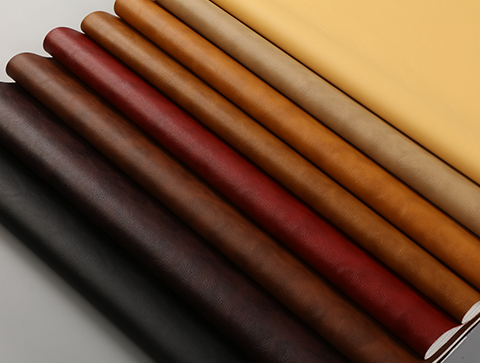
Illustrative image related to synthetic leather
2. Breathability
Breathability refers to the ability of the material to allow air and moisture to pass through. Synthetic leather generally has lower breathability compared to genuine leather. This characteristic can affect comfort in applications such as clothing and upholstery. For manufacturers targeting markets in hotter climates, selecting a more breathable synthetic option is crucial to ensure consumer satisfaction.
3. Durability
Durability indicates the material’s resistance to wear and tear over time. This includes resistance to abrasion, tearing, and cracking. While synthetic leather is generally durable, variations exist depending on the manufacturing process and material composition. Buyers should assess durability requirements based on the intended application, such as automotive upholstery or fashion accessories.
4. Environmental Impact
With growing awareness around sustainability, the environmental impact of synthetic leather is a significant consideration. Traditional PVC-based synthetic leathers pose biodegradability issues and can release harmful chemicals during production. However, newer vegetable-based alternatives are emerging, which can mitigate these concerns. Understanding the environmental footprint can help businesses align with eco-conscious consumers and regulations.
5. Tolerance and Thickness
Tolerance refers to the allowable variation in the thickness of synthetic leather, which typically ranges from 0.5mm to 2mm. The thickness affects the material’s flexibility and application suitability. For instance, thicker synthetic leather might be preferred for upholstery, while thinner options are better for fashion items. Buyers should specify tolerance requirements to ensure product consistency and quality.
What Are Common Trade Terminology Terms Related to Synthetic Leather?
Familiarizing yourself with industry jargon can facilitate smoother transactions and negotiations. Here are several essential terms to understand:
1. OEM (Original Equipment Manufacturer)
An OEM is a company that produces parts or equipment that may be marketed by another manufacturer. In the context of synthetic leather, an OEM may create custom synthetic leather products for brands that do not have manufacturing capabilities. Understanding OEM relationships can help businesses strategize their supply chains effectively.
2. MOQ (Minimum Order Quantity)
MOQ is the smallest number of units a supplier is willing to sell. This term is crucial for B2B buyers as it directly impacts inventory management and cost-effectiveness. Knowing the MOQ helps in budgeting and determining whether a supplier aligns with a company’s production needs.
3. RFQ (Request for Quotation)
An RFQ is a formal process used to solicit price quotes from suppliers for specific products or services. For synthetic leather, issuing an RFQ can help businesses compare prices and terms from multiple suppliers, ensuring they make cost-effective decisions.
4. Incoterms (International Commercial Terms)
Incoterms are a set of internationally recognized rules that define the responsibilities of buyers and sellers in international transactions. They clarify who is responsible for shipping, insurance, and tariffs. Understanding Incoterms helps B2B buyers manage risks and costs associated with importing synthetic leather.
5. Lead Time
Lead time refers to the amount of time it takes from placing an order to receiving the goods. For businesses that rely on synthetic leather, knowing the lead time is crucial for planning production schedules and meeting customer demands.
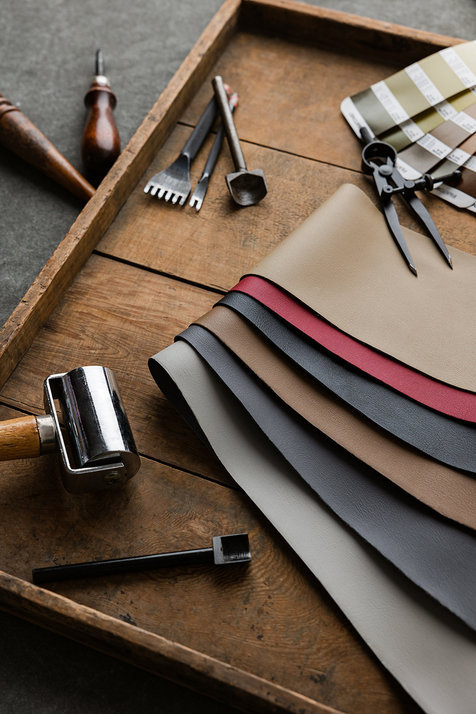
Illustrative image related to synthetic leather
By grasping these technical properties and trade terms, B2B buyers can navigate the synthetic leather market more effectively, ensuring they select the right products and establish beneficial supplier relationships.
Navigating Market Dynamics and Sourcing Trends in the synthetic leather Sector
What Are the Key Market Dynamics and Trends Affecting the Synthetic Leather Sector?
The global synthetic leather market is experiencing robust growth, driven by increasing demand across various sectors, including automotive, fashion, and upholstery. Emerging economies, particularly in Africa and South America, are witnessing a rise in disposable income, leading to heightened consumer demand for affordable yet stylish alternatives to genuine leather. This trend is mirrored in the Middle East and Europe, where the push for sustainable and cruelty-free materials is gaining momentum. Technological advancements in manufacturing processes are further enhancing the quality and versatility of synthetic leather, allowing for customized designs and improved durability.
B2B buyers should be aware of the shift towards digital sourcing platforms, which are becoming essential for connecting manufacturers with suppliers and retailers. These platforms facilitate transparent supply chain management, making it easier for businesses to find reliable partners globally. Additionally, artificial intelligence and data analytics are being integrated into sourcing strategies, enabling companies to forecast trends and manage inventory more efficiently. With the rise of e-commerce, international buyers can expect a more streamlined procurement process, allowing for quicker turnaround times and improved cost efficiency.
How Are Sustainability and Ethical Sourcing Influencing Synthetic Leather Production?
The environmental impact of synthetic leather production has prompted a critical evaluation of sourcing practices within the industry. Traditional synthetic leathers, primarily made from PVC and PU, have faced scrutiny for their non-biodegradable properties and the harmful chemicals released during manufacturing. In response, there is a growing emphasis on sustainability and ethical sourcing among international buyers. Companies are increasingly prioritizing suppliers that adhere to stringent environmental standards and utilize eco-friendly materials.
The emergence of plant-based synthetic leathers represents a significant shift towards more sustainable options. These materials are derived from renewable resources, reducing the reliance on petroleum-based products and minimizing environmental harm. Certifications such as Global Organic Textile Standard (GOTS) and OEKO-TEX® are becoming crucial for B2B buyers looking to ensure their supply chains align with sustainability goals. By sourcing ethically produced synthetic leather, businesses not only enhance their brand reputation but also cater to a growing consumer base that values environmental responsibility.

Illustrative image related to synthetic leather
What Is the Evolution of Synthetic Leather in the B2B Landscape?
The evolution of synthetic leather dates back to the early 20th century, with significant milestones that shaped its market presence. Initially developed as a wartime substitute for genuine leather, synthetic leather gained popularity due to its affordability and versatility. The introduction of Naugahyde in the 1920s marked a pivotal moment, as it became synonymous with synthetic leather and was widely adopted in various applications.
Over the decades, advancements in manufacturing technology have transformed synthetic leather production, leading to improved quality and a broader range of applications. The rise of eco-conscious consumers has further fueled innovation, pushing manufacturers to explore sustainable alternatives. Today, synthetic leather is not only a viable alternative to genuine leather but also a dynamic sector that adapts to the evolving needs of B2B buyers across the globe. As sustainability continues to shape consumer preferences, the synthetic leather market is poised for continued growth and transformation, presenting ample opportunities for international businesses.
Frequently Asked Questions (FAQs) for B2B Buyers of synthetic leather
-
How do I choose the right type of synthetic leather for my products?
Selecting the appropriate synthetic leather depends on your product application, desired aesthetics, and performance requirements. For upholstery, consider durability and ease of cleaning, while for apparel, flexibility and breathability are essential. Evaluate material types such as PVC and PU, which offer distinct qualities. Request samples from suppliers to assess texture, color, and performance under real-world conditions, ensuring they align with your brand’s vision and quality standards. -
What are the key factors to consider when vetting suppliers of synthetic leather?
When vetting suppliers, assess their manufacturing capabilities, quality control processes, and compliance with international standards. Look for certifications such as ISO and REACH to ensure environmental and safety regulations are met. Additionally, review their production capacity, lead times, and customer service responsiveness. Engaging with references or existing customers can provide insights into reliability and product quality, which are crucial for long-term partnerships. -
What customization options are typically available for synthetic leather?
Many suppliers offer customization options, including color matching, embossing, and varying thicknesses. You can often request specific textures or finishes to align with your branding. Discuss minimum order quantities (MOQs) for customized products, as these may vary significantly between manufacturers. Collaborating with your supplier during the design process can ensure that the final product meets your precise requirements, enhancing your brand’s market presence. -
What is the typical minimum order quantity (MOQ) for synthetic leather?
MOQs for synthetic leather can vary widely based on the supplier and the complexity of your order. Generally, MOQs can range from 100 to 1,000 yards or more for standard materials. For customized options, the MOQ may be higher due to the additional costs involved in production setup. It’s essential to discuss your specific needs with potential suppliers to understand their policies and negotiate terms that suit your business model. -
What payment terms should I expect when sourcing synthetic leather internationally?
Payment terms can vary by supplier and region but typically include options such as advance payment, letters of credit, or payment upon delivery. For first-time orders, suppliers may request a partial upfront payment (30-50%) to cover initial production costs. It’s crucial to clarify payment terms upfront to avoid misunderstandings. Additionally, consider the impact of currency fluctuations and international transaction fees when budgeting for your orders. -
How can I ensure quality assurance (QA) for my synthetic leather products?
Implementing a robust QA process is essential for maintaining product consistency. Work with suppliers who have established QA protocols, including material testing and inspections at various production stages. Request certifications and test reports to verify compliance with industry standards. Additionally, consider conducting third-party inspections or audits to ensure that the final products meet your specifications before shipment. -
What logistics considerations should I keep in mind when importing synthetic leather?
Logistics play a vital role in the successful importation of synthetic leather. Consider shipping methods, freight costs, and transit times, which can vary significantly based on the origin and destination. Ensure compliance with customs regulations and tariffs applicable to synthetic leather in your country. Working with a reliable freight forwarder can streamline the shipping process and help manage documentation, ensuring timely delivery to your location. -
What environmental concerns should I consider when sourcing synthetic leather?
Sourcing synthetic leather raises environmental considerations, particularly regarding the materials used and the production process. Look for suppliers that offer eco-friendly alternatives, such as vegetable-based synthetic leather, which addresses biodegradability and chemical emissions. Understanding the environmental impact of your sourcing choices can enhance your brand’s sustainability profile and appeal to environmentally conscious consumers, making it a key factor in your procurement strategy.
Top 5 Synthetic Leather Manufacturers & Suppliers List
1. Sewport – Faux Leather Solutions
Domain: sewport.com
Registered: 2015 (10 years)
Introduction: Faux leather, also known as synthetic leather, is a petroleum-based alternative to genuine leather. It is soft to the touch, water-resistant, and highly resistant to stains, making it easy to clean. While less durable than real leather, it is resistant to abrasions and cuts, ideal for upholstery in homes with children or pets. Faux leather can be produced in various colors, including unconventiona…
2. Decorative Fabrics Direct – PU Leather & Faux Leather
Domain: decorativefabricsdirect.com
Registered: 2004 (21 years)
Introduction: PU Leather & Faux Leather | Vinyl Upholstery Fabric, Free Shipping Coupon Code: SHIPFREE for Most $199 Orders, Available in various colors including Black, Gray, Blue, Turquoise, Aqua, Brown, Beige, Green, Orange, Coral, Purple, Red, Pink, White, Yellow, Gold. Types include Polycarbonate, Urethane, Vinyl (PVC). Brands include Naugahyde, Omnova Boltaflex, Nassimi, Spradling. Suitable for Furniture,…
3. Big Z Fabric – Faux Leather
Domain: blog.bigzfabric.com
Registered: 2010 (15 years)
Introduction: Faux Leather: Composite material with a fabric base (polyester, cotton) coated with polyurethane (PU) or polyvinyl chloride (PVC). Offers better breathability, mimics real leather, available in various colors and finishes. Commonly used in apparel, accessories, and upholstery. Solid Fetish Wet Glossy Upholstery Faux Leather Fabric: High gloss face, 100% polyester backing, non-stretch, 55″ width. V…
4. LeatherCult – Synthetic Leather Apparel
Domain: leathercult.com
Registered: 2010 (15 years)
Introduction: Synthetic leather is a substitute for real leather, commonly used in various garments such as jackets, vests, and trousers. It is made from a coated base material like nylon, rayon, or polyester, with a thin layer of polyurethane (PU) or polyvinyl chloride (PVC) applied over it. Synthetic leather is more susceptible to cracking compared to real leather due to its laminated construction. It emerged…
5. Reddit – Genuine vs. Synthetic Leather
Domain: reddit.com
Registered: 2005 (20 years)
Introduction: Genuine leather is of higher quality, ages well, and lasts longer compared to synthetic leather, which is cheaper and tends to look worse over time. Genuine leather has a nicer feel and is preferred for items like shoes and coats. Synthetic leather may be suitable for disposable clothing but lacks the durability and aesthetic appeal of real leather. Some people may judge the use of synthetic leath…
Strategic Sourcing Conclusion and Outlook for synthetic leather
In the competitive landscape of synthetic leather, strategic sourcing remains a vital component for international buyers. Understanding the diverse production methods, from traditional PVC to emerging vegetable-based alternatives, allows businesses to align their sourcing strategies with market demands while addressing sustainability concerns. As synthetic leather continues to gain traction across various applications—from upholstery to fashion—companies must prioritize suppliers that offer both quality and ethical production practices.
For B2B buyers, especially those in Africa, South America, the Middle East, and Europe, leveraging strategic partnerships can unlock new opportunities for innovation and cost efficiency. The global market for synthetic leather is poised for growth, driven by rising consumer preferences for cruelty-free and environmentally friendly products.
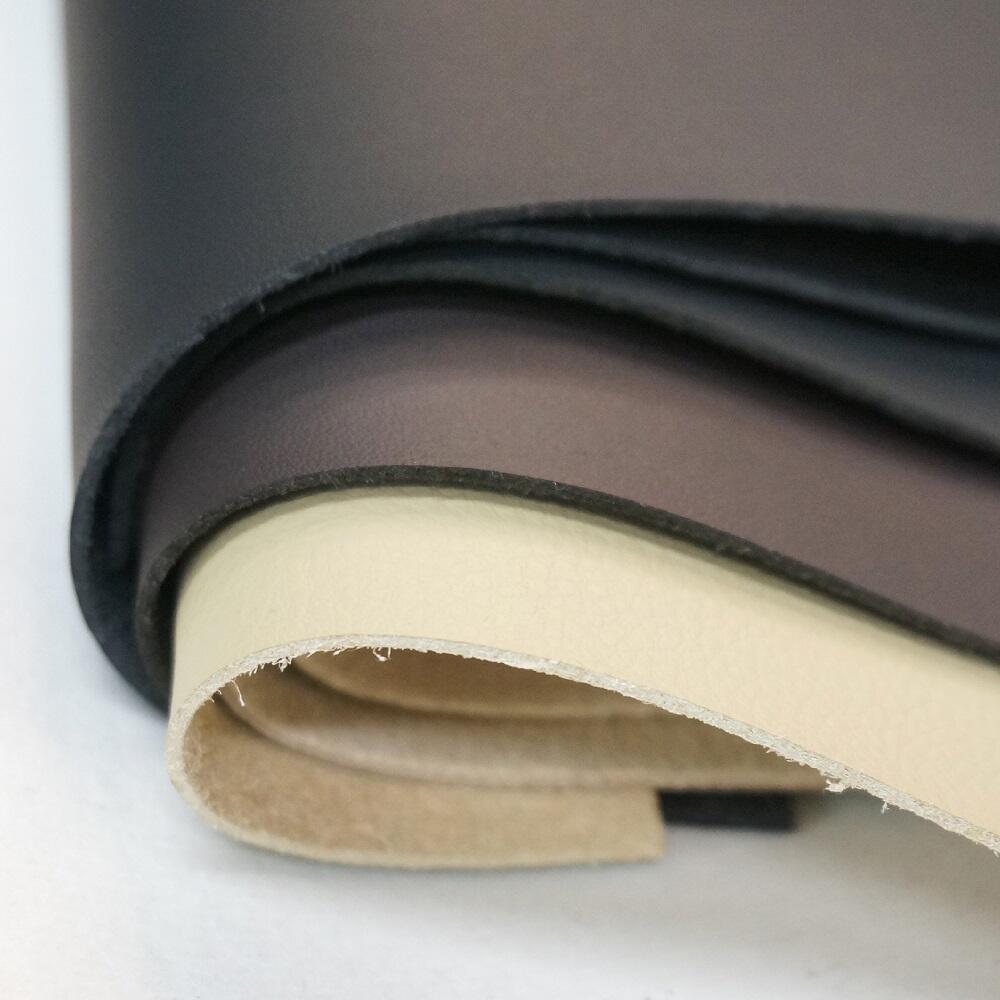
Illustrative image related to synthetic leather
As we look ahead, now is the time for buyers to engage with reliable manufacturers and explore sustainable options that not only meet their product needs but also enhance their brand reputation. Embrace the evolution of synthetic leather and position your business for success in a rapidly changing marketplace. Take action today—start evaluating your sourcing strategies and connect with suppliers that align with your vision for the future.
Important Disclaimer & Terms of Use
⚠️ Important Disclaimer
The information provided in this guide, including content regarding manufacturers, technical specifications, and market analysis, is for informational and educational purposes only. It does not constitute professional procurement advice, financial advice, or legal advice.
While we have made every effort to ensure the accuracy and timeliness of the information, we are not responsible for any errors, omissions, or outdated information. Market conditions, company details, and technical standards are subject to change.
B2B buyers must conduct their own independent and thorough due diligence before making any purchasing decisions. This includes contacting suppliers directly, verifying certifications, requesting samples, and seeking professional consultation. The risk of relying on any information in this guide is borne solely by the reader.


